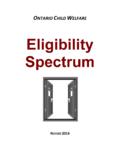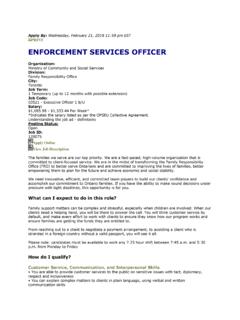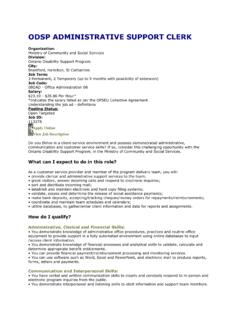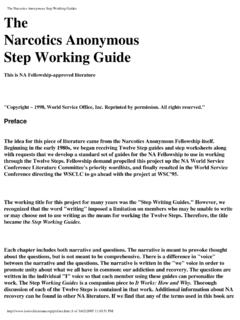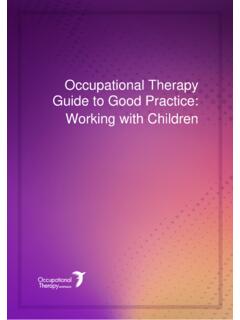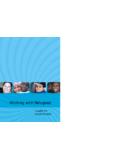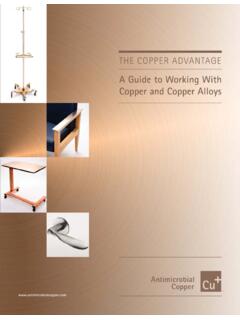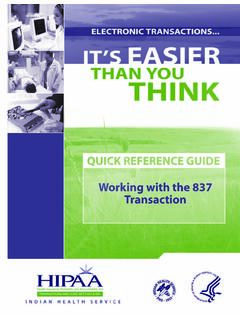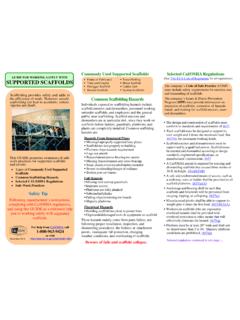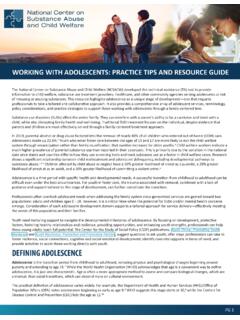Transcription of A Practice Guide for Child Welfare Professionals Working ...
1 The Other Side of the DoorA Practice Guide for Child Welfare Professionals Working with First Nations, Inuit and M tis PeoplesThe Other Side of the DoorA Practice Guide for Child Welfare Professionals Working with First Nations, Inuit and M tis PeoplesSecond EditionThe Other Side of the Door: A Practice Guide for Child Welfare Professionals Working with First Nations, Inuit and M tis Peoples is the property of the Ontario Association of Children s Aid Societies (OACAS). This Practice Guide was developed by the OACAS and the OACAS reserves the sole right to alter and modify the document as required. Materials reproduced from other sources which appear in this Guide are copied, under license, from Access Copyright, the Canadian Copyright Licensing Agency. Reproduction or distribution of the materials contained herein is not permitted without express written permission from the OACAS.
2 OACAS, 2014. 1 AcknowledgementsWRITER Kenn Richard EDITORSO ntario Association of Children s Aid Societies (OACAS) Krista Rivet Hannah McIntyre Erika SteibeltARTWORK Isaac Weber, 7th Generation Image Makers (Cover art and selected illustrations) Krista Rivet, OACAS (Selected illustrations) Krysha Littlewood (Design Concept)PROJECT ADVISORY COMMITTEE AND REVIEWERSThe development of this Guide was steered by an OACAS internal advisory committee including Karen Hill, Bernadette Gallagher, Erika Steibelt, Krista Rivet, Ruth Harper and Allan Moyle. Advice was also sought from the OACAS Aboriginal Services Advisory Committee. Thank you to the many organizations who took the time to review the Guide and provide constructive feedback. We would also like to thank the participants of the focus groups at Ottawa CAS and the Ottawa Inuit Children s Centre who provided useful information for this Guide .
3 FUNDING PROVIDED BY the Government of Ontario CONTACT Ontario Association of Children s Aid Societies75 Front St. East, Suite 308 Toronto, ON M5E 1V9 Tel: 416 -987-7725 Fax: 416-366-8314 Toll Free: 800-718-1797 SUGGESTED CITATION Ontario Association of Children s Aid Societies. (2014). The Other Side of the Door: A Practice Guide for Child Welfare Professionals Working with First Nations, Inuit and M tis Peoples (2nd ed.). Toronto, ON: OACAS. 2 Author s Note to the ReaderWhenever one writes about a specific group of people, and attempts a description of who they are, it becomes by definition an exercise in stereotyping, one dimensionality, and over-simplification. In the case of this Guide , certain ideas and concepts can easily be construed this way. In no way can one summarize the multiple historical, cultural and political dynamics defining First Nations, Inuit and M tis (FNIM) peoples and their communities within the narrative that follows.
4 What is provided is an overall orientation to Working within the FNIM context. Caution needs to be exercised, lest we confuse ourselves by thinking this is all we need to know and alienate those we seek to better order to avoid the worst of this, the reader is encouraged not to take this Guide alone as their reference. While we believe that it will be a helpful tool in your work with FNIM families and communities, it cannot act as your sole guidance on this complex and ever-changing order to truly achieve movement toward improving outcomes for FNIM children, practitioners will need to engage FNIM people themselves, personally and within their specific communities, in a respectful dialogue of mutual discovery, engagement, and hopefully relationship. This is the essence of this Guide and the reason it was Richard3 ContentsAcknowledgements.
5 1 Author s Note to the Reader ..2 Introduction ..6 The Use of Language in this Guide ..6 The Use of Reflection Questions ..7 Why this Guide is Needed ..8 What Will Be Achieved? ..9 The Other Side of the Door ..10 Your Side of the Door ..10 The Other Side of the Door ..11 From Oppression to Alliance ..13 Considerations for Effective Interventions ..13 The Power Dynamic ..14 Before They Came: FNIM Communities Pre-Contact ..16 FNIM Community Diversity in Ontario ..17 The Evolution of FNIM and European Relations ..18 The Move to Domination ..19 The Legacy of Residential Schools ..22 Child Welfare in Ontario and the 60s Scoop ..26A New Consciousness: Moving Past Colonialism ..30 The Colonial Legacy: Inter-generational Trauma and its Impact ..31 Lateral Violence ..33 Reorienting Child Welfare : FNIM Peoples and Children s Rights.
6 34 Going Forward: Restoring Power to FNIM Peoples ..37 Obligations and Mandates when Working with FNIM Populations ..39 Non-FNIM CAS Obligations..39 The Child and Family Services Act: Part X ..394 Working With FNIM Peoples, Their Communities and Their Agencies ..44 Building Positive Organizational Relationships ..44 Nation to Nation ..45 The Need for Protocols ..45 Reconciliation ..46 Governance ..47 Restoration: Working with Pre-mandated Agencies ..47 Cultural Understanding ..49 Honouring FNIM Peoples ..49 FNIM Worldviews ..50 A Reflection on Cultural Paradigms ..53 The Client Experience: Jumping Through Hoops ..55 Foundations of Practice ..58 Cultural Competence and Safety ..58 Anti-Oppressive Practice ..59 Practice Tips for Engaging with FNIM Families ..61 Wise Practices in Child Welfare ..62 Cornerstones of Practice .
7 64 Family Services ..64 Customary Care ..64 Healing ..65 Spirituality ..66 Repatriation ..67 Culture Based Alternative Dispute Resolution ..69 FNIM Children in Care..70 Identity Development ..71 Cultural Programming in Plans of Care ..72 The Sacred Bundle : Cultural Support to Children in Care..75 Other Considerations ..76 Learning from FNIM Peoples ..77 The Journey Continues .. 795 Appendices ..81 Appendix 1: OACAS Commitment and Strategic Directions pertaining to First Nations Child Welfare ..82 Appendix 2: A List of Mandated and Pre-mandated FN Children s Aid Societies ..83 Appendix 3: Formal Customary Care Schematic ..86 Appendix 4: Who is Aboriginal? The Indian Act and Federal Statutory Definitions ..87 Appendix 5: Demographic Profile of FNIM Peoples in Ontario ..89 Appendix 6: Becoming an Ally.
8 90 Appendix 7: Additional Resources ..91 Index of Common Terms ..92 References ..946 IntroductionIn 2012-13, OACAS undertook a review of the Child Welfare Professional series of training curricula, with the purposes of identifying and strengthening training content related to Working with First Nations, Inuit and M tis (FNIM) families. Based on the review, the OACAS endeavoured to create a Practice Guide that Child Welfare Professionals would be encouraged to read within one month of employment at a children s aid society. The objectives of the Practice Guide are that Child Welfare Professionals will: Be sensitized to the history of colonization within Child Welfare Understand the requirements of Child Welfare Practice when Working with FNIM families and communities Be better prepared to fulfill their unique obligations under the Child and Family Services Act (CFSA) with respect to Child Welfare Practice and providing services to FNIM familiesWhile the information presented in this Practice Guide is intended to steer you toward enhanced and more effective Practice , there is no one-size-fits-all approach in serving FNIM families.
9 For some, reading this Guide may represent a first step in a continuing journey of learning about Child Welfare Practice . In order to be a reflective and responsible Child Welfare practitioner, it is your duty to further your learning by making connections with the FNIM community nearest of 2011, there are 206 FNIM communities in Ontario (Government of Canada, 2011). Every FNIM community has its own rich history and complex story. In recognition of the fact that FNIM communities are diverse, evolving, and ever-changing, this Practice Guide contains a broad historical background of interactions between Child Welfare , FNIM communities and the governments of the are encouraged to speak directly with the band representatives (for First Nations) and elders to learn more about the local FNIM community s specific history. The Use of Language in this GuideThe term FNIM is used within this Guide to represent First Nations, Inuit and M tis peoples, except in cases where a specific people or group is identified.
10 While the term Aboriginal is often used within Canada to refer to First Nations, Inuit, and M tis peoples, regardless of their geographical location or status, it was felt that this term did not fully reflect the distinct and unique cultures, traditions, and languages of First Nations, Inuit and M tis peoples in Ontario, and Canada, as a whole. First Nations, Inuit and M tis peoples in Canada have their own terms to describe themselves, based on their own history, community, and culture. It is important, when Working with FNIM individuals and communities to use the language preferred by the community. 7 Aboriginal and Native are included only where directly quoted from secondary sources, to maintain the accuracy of the quotation. Source(s)Government of Canada. (2011). Ontario First Nations Map. Retrieved from Use of Reflection QuestionsThroughout this Guide you will encounter reflection questions that ask you to consider your experiences, thoughts, feelings, and knowledge.
